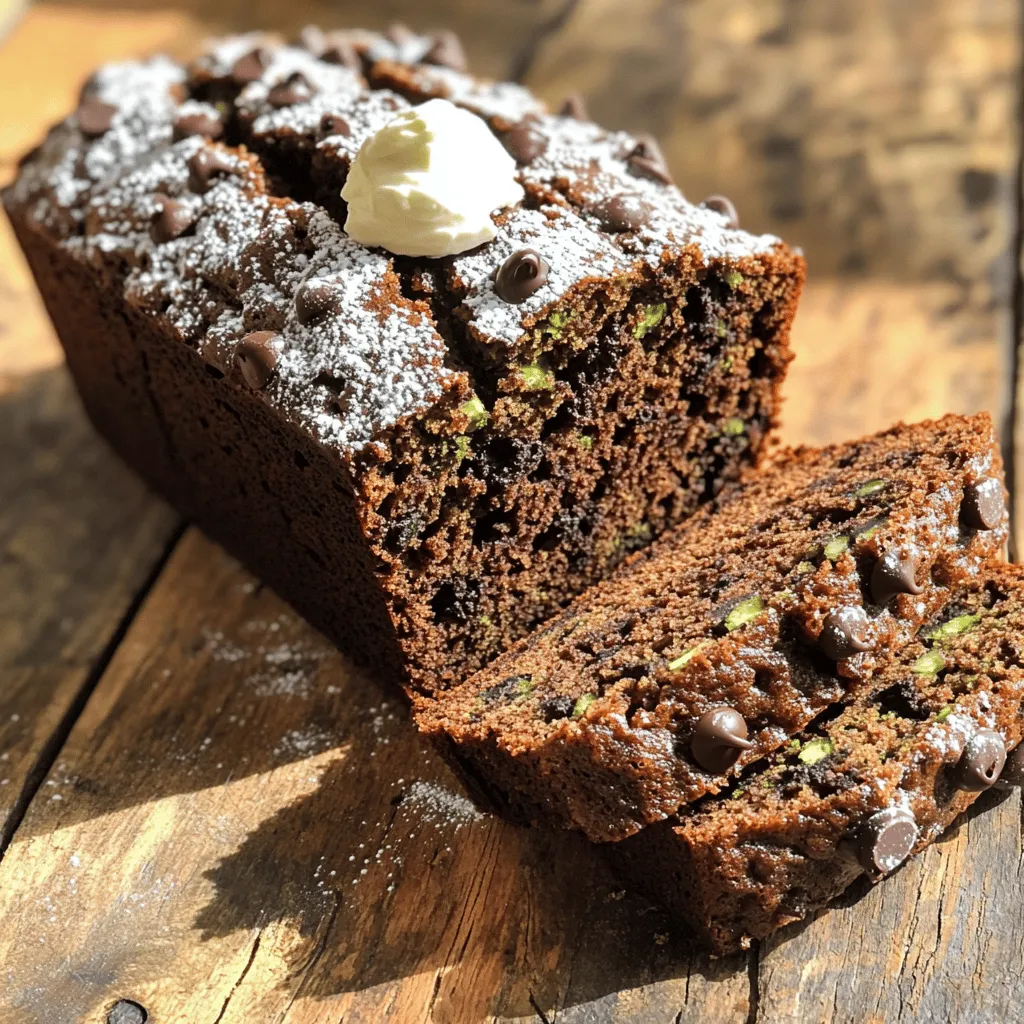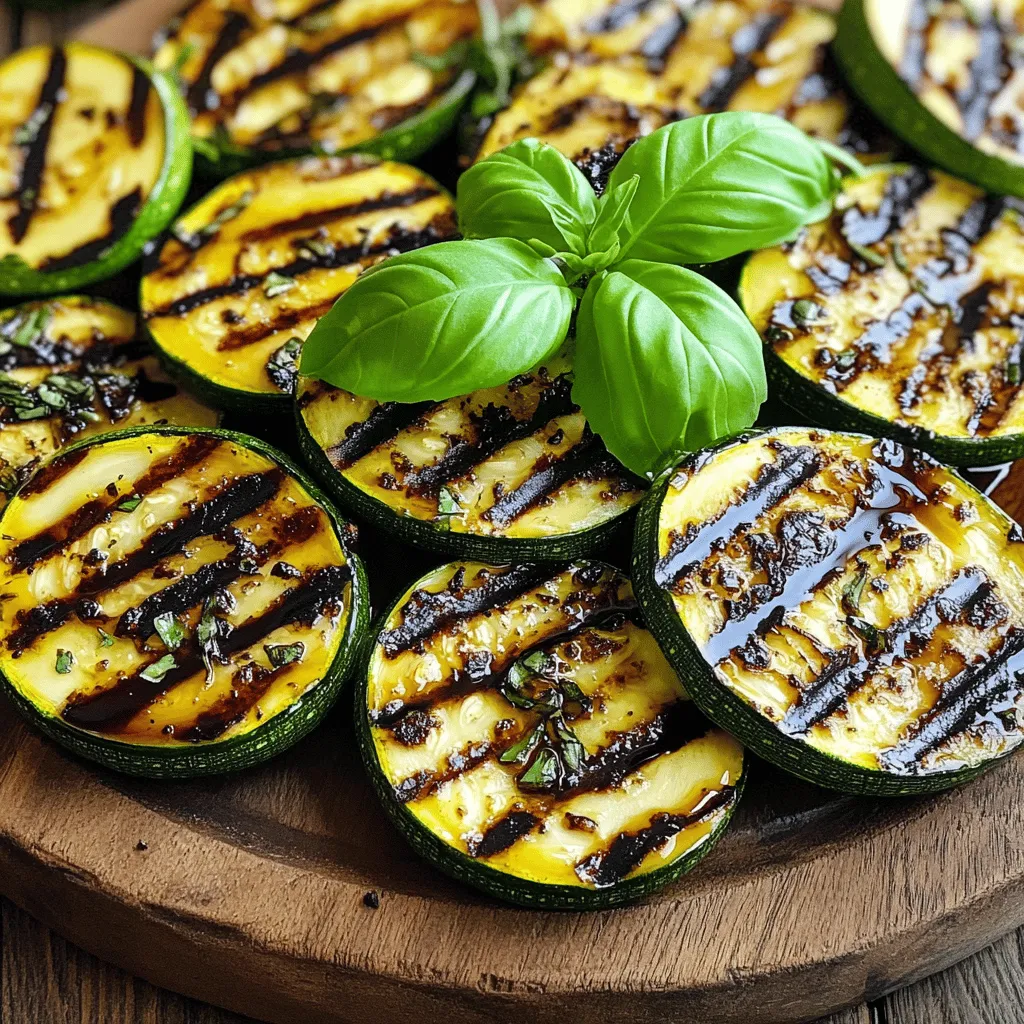Indulge in Decadent Chocolate Chip Zucchini Bread Delight
Ready to satisfy your sweet tooth? You’ll love my decadent chocolate chip zucchini bread! This easy recipe combines moist, grated zucchini with rich chocolate chips for a delightful treat. Whether …

. - Heat 2 tablespoons of olive oil in a large pot over medium heat. Add the finely chopped onion. Sauté for about 5 minutes until it turns soft and clear. - Next, add 2 cloves of minced garlic. Cook for another minute. This step adds a rich flavor to your chowder. - Pour in 4 cups of vegetable broth. Bring the mixture to a rolling boil. - Add 3 medium diced potatoes. Reduce the heat and let it simmer for about 10 minutes. The potatoes should be soft and tender by now. - Stir in 3 diced zucchinis and 1 cup of corn. Let the chowder simmer for another 5-7 minutes. This helps the zucchinis cook through without losing their crunch. - Now, add 1 cup of coconut milk, 1 teaspoon of dried thyme, and 1 teaspoon of smoked paprika. Season with salt and pepper to taste. Allow it to simmer for another 3-5 minutes. This melds the flavors together beautifully. - Use an immersion blender to blend the chowder. You can blend it until creamy or leave it chunky, depending on your preference. Check out the Full Recipe for detailed cooking times and tips! For the best zucchini chowder, focus on cooking temperatures. Sauté the onion on medium heat. This helps it become soft and sweet. When simmering, keep the heat low. This allows the flavors to blend well without burning. To achieve the perfect blend consistency, use an immersion blender. Blend until it’s creamy but still have some chunks. If you like it chunkier, blend less. Adjust the texture based on your taste. Presentation matters. Serve the chowder in deep bowls. Garnish with fresh parsley and a drizzle of olive oil. This adds flavor and brightens the dish. A sprinkle of smoked paprika also looks nice. Pair the chowder with crusty bread or a light salad. A fresh green salad balances the chowder's warmth. Bread soaks up the delicious broth, making each bite enjoyable. If the chowder tastes bland, adjust the seasoning. Add more salt or pepper a little at a time. Taste as you go to avoid overdoing it. Fresh herbs can also boost flavor. If your chowder is too thick, add more vegetable broth or coconut milk. Stir well and heat through. This keeps the flavors intact while adjusting the texture. Enjoy your creamy, comforting bowl of zucchini chowder! For the full recipe, check out the Zucchini Chowder Delight section above. {{image_2}} You can easily swap out some veggies in your zucchini chowder. Try carrots, celery, or bell peppers. These add more color and taste. If you want a different creamy texture, use heavy cream or yogurt instead of coconut milk. A non-creamy chowder works well too! You can skip the coconut milk for a lighter version. To spice things up, add cayenne pepper or red pepper flakes for heat. A little goes a long way! Fresh herbs can brighten your chowder. Try basil, dill, or cilantro for a refreshing twist. They add depth and make your bowl look beautiful. You can make this chowder vegan by using only vegetable broth and skipping any dairy. For a vegetarian option, stick to the coconut milk. If you need it gluten-free, just check your broth for any hidden gluten. Most vegetable broths are safe, but it's always good to verify. Enjoy your bowl of chowder, no matter your diet! Store your zucchini chowder in airtight containers. This keeps it fresh and tasty. You can keep it in the fridge for up to three days. Make sure it cools down before sealing. This helps prevent condensation. Always check for signs of spoilage before eating. To freeze zucchini chowder, let it cool completely. Pour it into freezer-safe containers. Leave some space at the top for expansion. You can freeze it for up to three months. When you're ready to eat, move it to the fridge overnight to thaw. Reheat it on the stove over low heat. Stir often to avoid burning. You can also use a microwave, but be careful not to overheat. Zucchini chowder lasts about three days in the fridge. When freezing, it stays good for three months. Look for changes in color or smell to know if it’s bad. If it smells sour or has mold, throw it away. Always trust your senses to keep your meals safe and delicious. Zucchini chowder is a thick, creamy soup. It features fresh zucchini, corn, and potatoes. This dish has a rich flavor from herbs and spices. Coconut milk adds creaminess without dairy. Each bowl bursts with comfort. You can enjoy it warm, perfect for any season. Yes, you can prepare zucchini chowder in advance. Cook the chowder and cool it down. Store it in an airtight container in the fridge. It stays fresh for about three days. You can also freeze it for up to three months. When ready to eat, just reheat it on the stove. To thicken your chowder, add more potatoes or blend it longer. You can also mix in a little cornstarch. For a thinner chowder, add more vegetable broth or coconut milk. Adjust the texture to your liking. A smooth blend gives a creamy feel, while chunky bits add texture. Zucchini chowder pairs well with crusty bread. You can also serve it with a fresh salad. A sprinkle of cheese on top adds flavor. For something extra, try a dollop of sour cream. These sides enhance the meal and make it more filling. Zucchini chowder is a healthy and tasty choice. This blog taught you how to make it with simple steps. You learned about key ingredients like zucchini, corn, and potatoes. We also covered tips for cooking, serving, and storage. Feel free to try variations to suit your taste. Enjoy making this chowder and share it with others. Your kitchen can be a place of fun and flavor!](https://grilledflavors.com/wp-content/uploads/2025/07/8d60e2e9-649e-4aad-a130-bead1458ee51.webp)



![To make a simple and delicious lemon vinaigrette, you need fresh and quality ingredients. Here’s what you will need: - Fresh lemon juice - Extra virgin olive oil - Dijon mustard - Honey or maple syrup - Garlic - Salt and pepper - Fresh herbs (parsley or basil) These ingredients come together to create a bright, zesty flavor. Fresh lemon juice gives that tartness we love. Extra virgin olive oil adds richness and depth. Dijon mustard brings a bit of spice and helps emulsify the dressing, making it smooth. Honey or maple syrup adds a touch of sweetness to balance the acidity. Garlic gives it a nice kick, while salt and pepper enhance all the flavors. Finally, fresh herbs add freshness and color to your vinaigrette. For the Full Recipe, follow the steps to whip up this tasty dressing. Experiment with the herbs you like best, or stick to classic parsley or basil. Enjoy bringing bright flavors to your meals! 1. Combining the base ingredients: Start by grabbing a small mixing bowl. Pour in 1/4 cup of fresh lemon juice. Add 1 tablespoon of Dijon mustard and 1 tablespoon of honey or maple syrup. Toss in one small minced garlic clove. Whisk these ingredients together until they blend well. 2. Emulsifying with olive oil: Slowly drizzle in 1/2 cup of extra virgin olive oil while you whisk. This step is key. It helps to emulsify the dressing, giving it a creamy texture. Keep whisking until the mixture is smooth and well combined. 3. Adjusting seasoning and flavor balance: Now, add salt and pepper to taste. I like to start with a pinch of each. Taste the dressing and see if you need to adjust it. If it’s too tart, add a bit more honey. If it’s too sweet, add a splash of lemon juice. Stir in 1 teaspoon of finely chopped fresh herbs for that extra pop of flavor. - Best ways to use lemon vinaigrette: This dressing shines on salads. Drizzle it over fresh greens or your favorite mixed salad. It also works great on grilled vegetables or as a marinade for chicken. - Drizzling technique over salads: When serving, use a light hand. Drizzle the vinaigrette in a circular motion across the salad. This technique ensures even coverage and makes your dish look pretty. - Keeping in refrigerator: Store the dressing in a jar with a tight lid. It will keep fresh in your refrigerator. - How long the dressing lasts: Homemade lemon vinaigrette lasts about one week in the fridge. Be sure to give it a good shake before each use, as it may separate over time. Enjoy your zesty creation! For the full recipe, check the ingredients and instructions above. To make your lemon vinaigrette shine, you can adjust the acidity and sweetness. If you like it tangy, add more lemon juice. For a sweeter taste, add a bit more honey or maple syrup. It’s all about finding the balance you enjoy. When mixing your vinaigrette, whisking well is key. Start by whisking the base ingredients in a bowl. Then, slowly drizzle in the olive oil while whisking. This process helps create a smooth texture. If you want an even creamier dressing, try using an immersion blender. Lemon vinaigrette packs a punch with its fresh ingredients. The main components have great nutritional value. Fresh lemon juice is high in vitamin C, which helps boost your immune system. Olive oil is filled with healthy fats that support heart health. Honey adds sweetness but also antioxidants. Using lemon vinaigrette can have several health benefits. It can aid digestion and promote hydration. The fresh herbs you add bring extra vitamins and minerals. This dressing not only tastes great, but it can also contribute to a healthy diet. {{image_2}} You can make your lemon vinaigrette even better. Adding fruits like berries or mango gives it a sweet twist. The burst of flavor pairs well with the tangy lemon. Try mixing in fresh herbs, too. Basil or mint can add a nice kick. You can also infuse the vinaigrette with spices. A pinch of cumin or paprika can change the taste. Experimenting with these flavors makes each batch unique. Lemon vinaigrette is not just for salads. You can pour it over pasta dishes for a zesty flair. Toss it with warm pasta and veggies for a delightful meal. It also works great as a marinade for proteins. Use it on chicken or fish before grilling. This adds flavor and helps keep the meat juicy. The options are endless, so get creative and enjoy! For the full recipe, check [Full Recipe]. To keep your lemon vinaigrette fresh, you need the right jars. A clean glass jar works best. Glass does not hold smells and keeps flavors intact. Always use an airtight container. This helps keep your dressing safe from air and light. For freshness, store your vinaigrette in the fridge. It will stay good for about a week. Before you use it, give it a good shake. The ingredients may separate, but that's normal. If you notice any off smells or colors, it is best to throw it away. Can you freeze lemon vinaigrette? Yes, you can! Freezing can help if you make too much. However, the texture may change a bit. Freezing can break the emulsion. This means it might look a bit different after thawing. To thaw, put it in the fridge overnight. If you need it quicker, run the jar under cool water. Once thawed, whisk it well to mix the ingredients again. If it looks clumpy, use a blender for a smooth finish. Enjoy it fresh on salads or as a dip! You can find the full recipe above to get started. Homemade lemon vinaigrette lasts about one week in the fridge. Store it in a sealed jar. Over time, the flavors may change a bit, but it should still taste good. Always check for signs of spoilage, like off-smells or changes in color. If you notice these, it’s best to toss it. You can use bottled lemon juice, but fresh is better. Fresh lemon juice tastes brighter and more vibrant. Bottled juice may have added preservatives, which can change the flavor. If you choose bottled juice, look for one without any additives for a closer taste to fresh. Lemon vinaigrette works well on many dishes. Drizzle it over mixed greens, spinach salads, or grilled vegetables. You can also use it on chicken, fish, or roasted potatoes. It adds a nice zing to pasta salads too. Feel free to get creative and try it on your favorite dishes! To make this recipe vegan, simply replace honey with maple syrup. Both sweeteners add flavor, but maple syrup is plant-based. Everything else in the recipe is already vegan-friendly, so you’re good to go! This way, everyone can enjoy this tasty lemon vinaigrette. For the full recipe, check the section above. This blog post covered everything you need to know about lemon vinaigrette. We explored key ingredients and how to make the dressing step by step. I shared ideas for serving, storage tips, and delightful variations. You learned about the health benefits and how to adapt the recipe. In summary, lemon vinaigrette is a versatile and healthy addition to your meals. Try it on salads, pasta, or as a marinade. Enjoy adding your own twist to this classic dressing!](https://grilledflavors.com/wp-content/uploads/2025/07/0f2771fb-ae94-4aed-92d8-927c7dfef188.webp)


![To make a Neapolitan Rose Cake, you need some key ingredients. Here’s what you will need: - 2 cups all-purpose flour - 1 ½ cups granulated sugar - ½ cup unsalted butter, softened - 1 cup milk - 3 large eggs - 2 teaspoons baking powder - 1 teaspoon vanilla extract - 1 cup strawberry puree (fresh or frozen) - 1 cup chocolate syrup - 1 cup whipped cream (for frosting) - Fresh strawberries and edible rose petals (for decoration) These ingredients create three delicious layers: vanilla, chocolate, and strawberry. Each layer brings its own flavor and charm. Using quality ingredients makes a big difference. Here are some tips: - Choose fresh strawberries for purees. They give a bright flavor. - Use real vanilla extract instead of imitation for a richer taste. - Select high-quality chocolate syrup. This enhances the chocolate layer. - For butter, choose unsalted. This lets you control the saltiness. - Use whole milk for a creamier texture in the cake. These small choices can elevate your cake from good to great! If you want to add some fun twists, try these optional add-ins: - Mix in lemon zest for a fresh, zesty flavor. - Add almond extract for a nutty touch. - Incorporate crushed nuts or chocolate chips for added texture. - Swirl in some raspberry puree for a tart punch. These options can help you personalize your cake and surprise your guests. Start by preheating your oven to 350°F (175°C). This step is key for a good bake. Grease and flour two 9-inch round cake pans. This will help the cake release easily later. In a large bowl, cream the softened butter and sugar. Mix them until light and fluffy, about 3 to 4 minutes. Next, add the eggs one by one. Mix well after adding each egg. Then, pour in the vanilla extract for flavor. In another bowl, whisk the flour and baking powder together. Gradually add this mixture to the butter mixture, alternating with the milk. Mix until just combined. Do not overmix. Now, divide the batter into three equal parts. In one part, stir in the strawberry puree. In the second part, mix in the chocolate syrup. Leave the last part plain. Pour each batter into the prepared pans. You will have layers of strawberry, chocolate, and vanilla. Bake for 25 to 30 minutes. Check with a toothpick; it should come out clean. Let the cakes cool for 10 minutes in the pans. Then transfer them to wire racks to cool completely. Once the cakes have cooled, it's time to stack them. Start with the vanilla layer on a cake plate. Spread a thick layer of whipped cream on top. Place the chocolate layer next. Again, add more whipped cream. Finally, add the strawberry layer on top. To keep the layers even, use a serrated knife to trim the tops of the cakes. This will help them sit flat. Make sure to press down gently to avoid breaking the layers. Now, you can frost the cake. Use a spatula to spread whipped cream on the top and sides. Don't worry if it’s not perfect; a little texture adds charm. To create a smoother look, dip your spatula in warm water before smoothing the frosting. For decoration, add fresh strawberries and edible rose petals on top. This gives the cake a lovely touch. For extra flair, place the cake on a nice stand. Add a drizzle of chocolate syrup on the plate for a beautiful presentation. Follow the Full Recipe for all the details. When making your Neapolitan Rose Cake, avoid overmixing the batter. This can make your cake dense and tough. Also, do not skip greasing and flouring the pans. It helps prevent sticking. Always check your oven temperature with an oven thermometer. An oven that is too hot can burn the edges while leaving the center raw. Lastly, let the cakes cool fully before frosting. This step is key for a clean finish. To keep your cake moist, use fresh ingredients. The butter should be softened but not melted. Use room-temperature eggs and milk for better mixing. Adding strawberry puree into the batter also adds moisture and flavor. After baking, you can brush simple syrup on the layers. Mix equal parts sugar and water, heat until the sugar dissolves, and let it cool. This enhances flavor and keeps the layers moist longer. To make your Neapolitan Rose Cake shine, use fresh strawberries and edible rose petals. Place the strawberries around the top edge. Arrange the petals in a circular pattern for a beautiful look. You can also drizzle chocolate syrup on the cake and the plate for extra flair. A simple cake stand can elevate the whole presentation. Get creative with colors and shapes, and make it your own! {{image_2}} You can change the flavors in your Neapolitan Rose Cake. Try using raspberry puree instead of strawberry for a fun twist. You can also mix in lemon zest to add a fresh zing. Consider using white chocolate instead of regular chocolate syrup. This adds a creamy taste to the cake. Each flavor will give your cake a unique touch! To make this cake gluten-free, swap the all-purpose flour for a gluten-free blend. Look for one that works well in baking. For dairy-free options, use coconut milk instead of regular milk. Use dairy-free butter and whipped cream too. These swaps keep the cake tasty while meeting dietary needs. Making mini cakes is a fun idea! Use muffin tins or small cake pans for these treats. Divide the batter into smaller portions. Bake them for a shorter time, about 15-20 minutes. Layer and frost them just like the big cake. Mini cakes are perfect for parties or special events. They are easy to serve and look adorable! For the full recipe, click [Full Recipe]. To keep your Neapolitan Rose Cake fresh, store it in an airtight container. This method helps prevent the cake from drying out. If you do not have a container, wrap the cake in plastic wrap. Place it in a cool, dry spot away from sunlight. Avoid storing it in the fridge unless it has whipped cream on top. The fridge can dry it out. To maintain the cake's flavor, you can add a layer of plastic wrap around the cake. This extra layer keeps the moisture locked in. If you plan to eat the cake within two days, keep it at room temperature. If you need to store it longer, the fridge is a better option. Just remember to bring it back to room temperature before serving. This way, the flavors will shine. To freeze Neapolitan Rose Cake, first, cool it completely. Wrap each slice in plastic wrap tightly. Then, place the slices in a freezer-safe bag or container. Label the bag with the date. You can freeze the cake for up to three months. When ready to eat, take it out and let it thaw in the fridge overnight. Enjoy the same great taste as when it was fresh. For the best results, frost the cake after thawing. For the full recipe, check out the complete guide! Neapolitan Rose Cake offers a lovely mix of flavors. You get sweet strawberry, rich chocolate, and light vanilla. Each bite is soft and creamy. The whipped cream adds a nice touch. The fresh strawberries and rose petals give it a fresh taste. Overall, it's a delightful cake that pleases many palates. Yes, you can use store-bought strawberry puree. It saves time and effort. Just make sure it's pure and has no added sugar. This will keep the cake sweet but not too sweet. If you want a fresher taste, try making your own. Blend fresh strawberries until smooth for the best flavor. You can keep the Neapolitan Rose Cake for about 3-4 days. Store it in the fridge to keep it fresh. Make sure to cover it well with plastic wrap. This will help keep it moist and tasty. If you want to keep it longer, you can freeze it. Just slice it first and wrap each slice tightly. The Neapolitan Rose Cake combines quality ingredients, a precise baking process, and smart tips. You learned how to create moist layers and stunning decorations. I shared fun variations and storage tips to keep your cake fresh. Now you can enjoy making this cake for any occasion. With these insights, you’ll impress friends and family with your baking skills. Remember, practice makes perfect, and every cake is a new chance to learn.](https://grilledflavors.com/wp-content/uploads/2025/07/1cb81bf8-823f-454d-ac85-2aa3ff55226d.webp)
